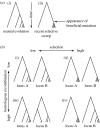Patterns and mechanisms of genetic and phenotypic differentiation in marine microbes
- PMID: 17062417
- PMCID: PMC1764928
- DOI: 10.1098/rstb.2006.1928
Patterns and mechanisms of genetic and phenotypic differentiation in marine microbes
Abstract
Microbes in the ocean dominate biogeochemical processes and are far more diverse than anticipated. Thus, in order to understand the ocean system, we need to delineate microbial populations with predictable ecological functions. Recent observations suggest that ocean communities comprise diverse groups of bacteria organized into genotypic (and phenotypic) clusters of closely related organisms. Although such patterns are similar to metazoan communities, the underlying mechanisms for microbial communities may differ substantially. Indeed, the potential among ocean microbes for vast population sizes, extensive migration and both homologous and illegitimate genetic recombinations, which are uncoupled from reproduction, challenges classical population models primarily developed for sexually reproducing animals. We examine possible mechanisms leading to the formation of genotypic clusters and consider alternative population genetic models for differentiation at individual loci as well as gene content at the level of whole genomes. We further suggest that ocean bacteria follow at least two different adaptive strategies, which constrain rates and bounds of evolutionary processes: the 'opportunitroph', exploiting spatially and temporally variable resources; and the passive oligotroph, efficiently using low nutrient concentrations. These ecological lifestyle differences may represent a fundamental divide with major consequences for growth and predation rates, genome evolution and population diversity, as emergent properties driving the division of labour within microbial communities.
Figures



References
-
- Acinas S.G, Rodríguez-Valera F, Pedrós-Alió C. Spatial and temporal variation in marine bacterioplankton diversity as shown by RFLP fingerprinting of PCR amplified 16S rDNA. FEMS Microbiol. Ecol. 1997;24:27–40. doi:10.1111/j.1574-6941.1997.tb00420.x - DOI
-
- Acinas S.G, Klepac-Ceraj V, Hunt D.E, Pharino C, Ceraj I, Distel D.L, Polz M.F. Fine-scale phylogenetic architecture of a complex bacterial community. Nature. 2004;430:551–554. doi:10.1038/nature02649 - DOI - PubMed
-
- Acinas S.G, Sarma-Rupavtarm R, Klepac-Ceraj V, Polz M.F. PCR-induced sequence artifacts and bias: insights from comparison of two 16S rRNA clone libraries constructed from the same sample. Appl. Environ. Microbiol. 2005;71:8966–8969. doi:10.1128/AEM.71.12.8966-8969.2005 - DOI - PMC - PubMed
-
- Azam F, Ammerman J.W. Cycling of organic matter by bacterioplankton in pelagic marine ecosystems: microenvironmental considerations. In: Fasham M.J.R, editor. Flows of energy and materials in marine ecosystems. Plenham Press; New York, NY: 1984. pp. 345–360.
Publication types
MeSH terms
LinkOut - more resources
Full Text Sources
